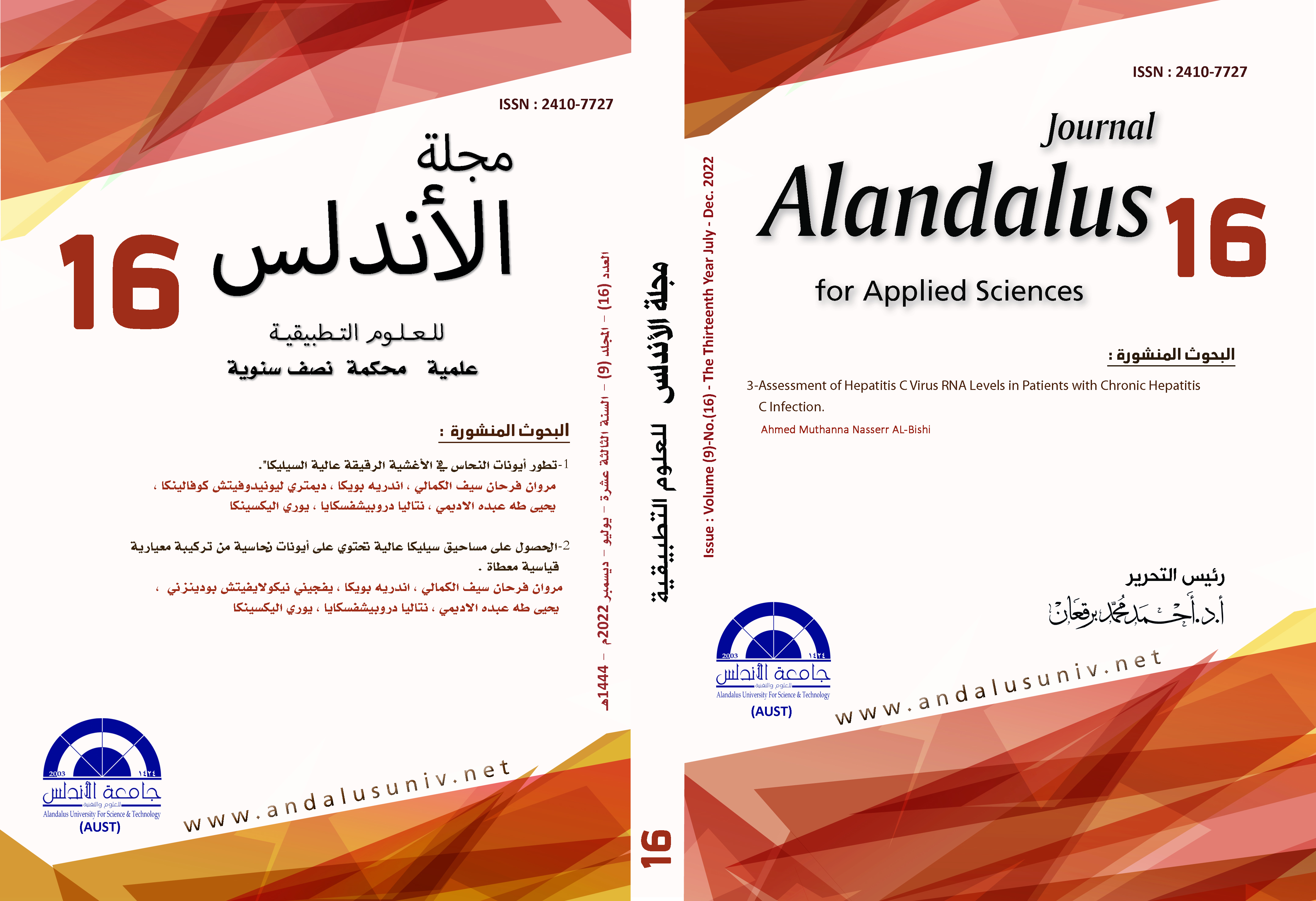الحصول على مساحيق سيليكا عالية تحتوي على أيونات نحاسية من تركيبة معيارية قياسية معطاة مروان فرحان سيف الكمالي1،*، اندريه بويكا1،†، يفجيني نيكولايفيتش بودينزني2 ، يحيى طه عبده الاديمي3، نتاليا دروبيشفسكايا1،يوري اليكسينكا1.
محتوى المقالة الرئيسي
الملخص
يعرض البحث نتائج دراسات المراحل التكنولوجية للحصول على مساحيق السيليكا العالية المحتوية على أيونات النحاس والمحضرة بطريقة السول-جيل. لقد ثبت أن الجسيمات النانوية المعدنية في مصفوفة الاكسروجيل هي أجسام ذات بنية نانوية وذات نشاط كيميائي عالي "الاختراق" فيما يتعلق بحدوث تفاعلات سطحية محفزة حرارياً. بينما تحتفظ مصفوفة SiO2 بنظام غير متبلور، بينما يشكل CuO&Cu° نظام بلوري أحادي الميل.. بناءً على نتائج بيانات SEM تم اقتراح أن المعدن المختزل يمتص في البنية الكروية لـلإكسروجيل، مكونًا طبقة مركبة رقيقة على سطح SiO2.
لم يتم العثور على تشكيل واضح لجسيمات النحاس الدقيقة والنانوية المترجمة بشكل منفصل من SiO2 عالي السيليكا الذي تم الحصول عليه من مساحيق التركيبات(SiO2:CuO)و(SiO2:Cu°)،حيث تم تشكيل أهداف لترسيب الأغشية الرقيقة بواسطة شعاع إلكتروني أو مغنطروني بقطر يصل إلى 80 ملم.
الكلمات المفتاحية: الاكسروجيل،السول-جل، SiO2:CuO،SiO2:Cu°،المرفولوجيا (التشكيل السطحي)، السيليكا العالية، طيف الأشعة السينية، مجهر المسح الالكتروني، ميكرو-نانو بودر(المساحيق الميكرونية والنانوية ).
تفاصيل المقالة
المراجع
المراجع والمصادر
Hench Larry L., West Jon K. The sol-gel process // Chem. Reviews. – 1990. - Vol. 90, № 1. – P. 33-72.
Hrubesh L.W., Poco J.F. Thin aerogel films for optical, thermal, acoustic and electronic applications. // J. Non-Cryst. Solids. – 1995. – Vol. 188. – P. 46-53.
Segal D.L. Sol-gel processing: routes to oxide ceramics using colloidal dispersions of hydrous oxydes and alkoxyde intermediates // J.Non-Cryst. Solids. – 1984. - Vol.63. - P.183-191.
Sheppard, L.M. Low-Temperature Synthesis of Ceramics // Adv. Vat. and Process. inc. Metal Progr. – 1986. – Vol.130, №5. – P.47-51
Ogihara T. Hydrolysis of Metal Alkoxides in Homogeneous Solutions // in Fine Particles Synthesis, Characterisation and Mehanism of Gronth/ Ed. T.Sugimoto. – N.-Y., Basel. – 2000. – P.35-57.
Arbenin A. Yu., Zemtsova E. G., Smirnov V. M. Synthesis of iron nanoparticles in mesoporous silica sba-15 and chemical composition analysis. Vestnik Sankt-Peterburgskogo universiteta. Fizika i khimiya = Vestnik of Saint Petersburg University. Physics and Chemistry, 2012, vol. 4, pp. 136–138 (in Russian).
AL-Kamali M.F.S.H. Alekseenko A.A., Titenkov О.А. Structure formation of SiO2-xerogels containing copper compounds of different phase composition // Scientific and technical journal «problems of physics, mathematics and technics». - 2020. - № 3 (44). – P.7-12. (In Russ.).
Al-Kamali M. F. S. H., Boika A. A., Al-Shamiri H. A. S. SiO2:CuO (Cu°) targets for depositing thin films of ion-beam spraying obtained by sol-gel method. Doklady Natsional’noi akademii nauk Belarusi = Doklady of the National Academy of Sciences of Belarus, 2022, vol. 66, no. 3, pp. 348–355 (in Russian). https://doi.org/10.29235/1561-8323-2022-66-3-348-355
Al-Kamali M.F.S.H., Zalizny D.I., Boika A.A., Fedosenko N.N. Electrical properties of SiO2:Cuº thin films produced by pulse laser deposition, problems of physics mathematics and technics( Francisk Skorina Gomel State University),2022, № 2(51) p. 7-11 (in Russian).
Structural properties of micropowders composition SiO2:CuO & SiO2:Cu° prepared by sol-gel method / M.F.S.H. AL-Kamali [et al.] // Al-Andalus J. Appl. Scien. – 2021. – № 13 (January –June). – P. 99–117.
Poddenezhny Е. N., Boiko A. A.. Sol-gel synthesis of optical quartz glass. Gomel, 2002. 210 p. (in Russian).
Villa N., Golosov D. A., Nguyen T. D. Formation of titanium oxide thin films by reactive magnetron sputtering. Doklady BGUIR, 2019, no. 5 (123), pp. 87–93 (in Russian). https://doi.org/10.35596/1729-7648-2019-123-5-87-93.
Evstropiev S.K., Nikonorov N.V. Liquid Methods for Obtaining Optical Nanomaterials: Study book - Saint Petersburg: ITMO University, 2018. - p. 84. (in Russian).
Semchenko A.V., Sidsky V.V., Tyulenkova O.I. Study of the sorption properties of silica gels obtained by the sol-gel method, Problems of physics, mathematics and technology. - 2018. - No. 1 (34). - pp. 38-40.(in Russian).
